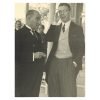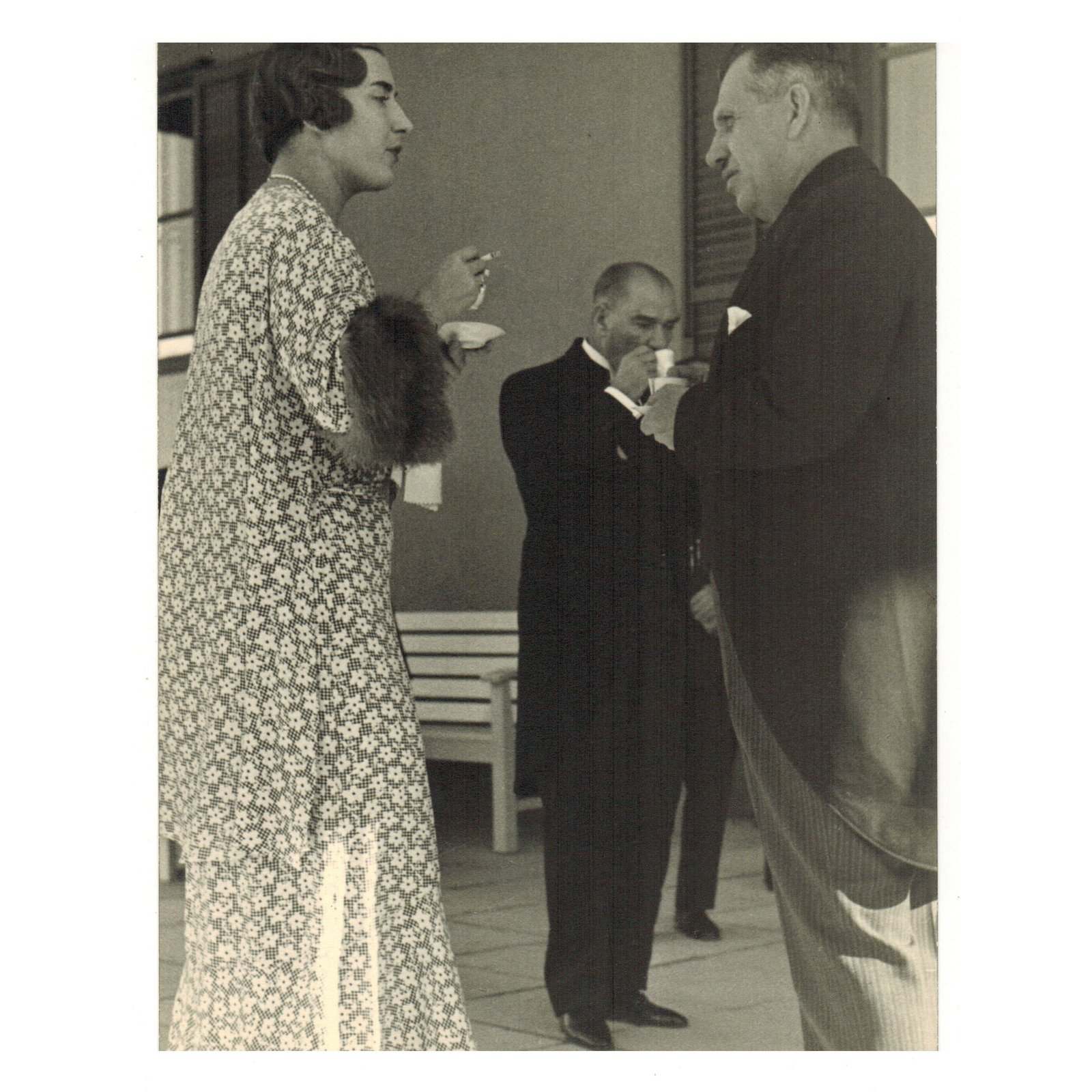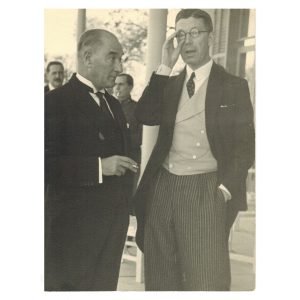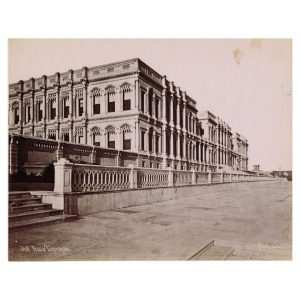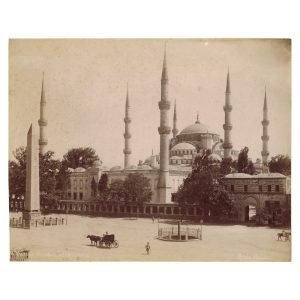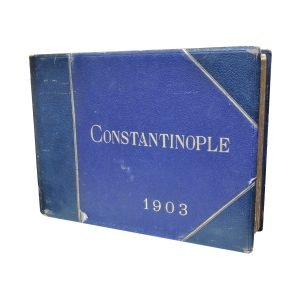Mustafa Kemal Atatürk
Kemal Atatürk (until 1934: Mustafa Kemal Pasha, Ottoman Turkish: مصطفى كمال پاشا; after 1935: Kamâl Atatürk; 19 May 1881 (conventional) – 10 November 1938), commonly referred to as Mustafa Kemal Atatürk (/ˈmʊstəfə kəˈmɑːl ˈætətɜːrk/; Turkish: [mustaˈfa ceˈmal aˈtatyɾc]), was a Turkish field marshal (Mareşal), revolutionary statesman, author, and founder of the Republic of Turkey, serving as its first President from 1923 until his death in 1938. His leadership undertook sweeping liberal reforms, which modernized Turkey into a secular, industrial nation. Ideologically a secularist and nationalist, his policies and theories became known as Kemalism.
Atatürk came to prominence for his role in securing the Ottoman Turkish victory at the Battle of Gallipoli (1915) during World War I. Following the Empire’s defeat and subsequent dissolution, he led the Turkish National Movement, which resisted the mainland Turkey’s partition among the victorious Allied powers. Establishing a provisional government in the present-day Turkish capital Ankara, he defeated the forces sent by the Allies, thus emerging victorious from what was later referred to as the Turkish War of Independence. He subsequently proceeded to abolish the decrepit Ottoman Empire and proclaimed the foundation of the Turkish Republic in its place.
As the president of the newly formed Turkish Republic, Atatürk initiated a rigorous program of political, economic, and cultural reforms with the ultimate aim of building a modern, progressive, and secular nation-state. He made primary education free and compulsory, opening thousands of new schools all over the country. He also introduced the Latin-based Turkish alphabet, replacing the old Ottoman Turkish alphabet. Turkish women received equal civil and political rights during Atatürk’s presidency ahead of many Western countries. In particular, women were given voting rights in local elections by Act no. 1580 on 3 April 1930 and a few years later, in 1934, full universal suffrage, earlier than most other countries in the world.
His government carried out a policy of Turkicisation trying to create a homogeneous and unified nation. Under Atatürk, non-Turkish minorities were pressured to speak Turkish in public, non-Turkish toponyms and last names of minorities had to be changed to Turkish renditions. The Turkish Parliament granted him the surname Atatürk in 1934, which means “Father of the Turks”, in recognition of the role he played in building the modern Turkish Republic. He died on 10 November 1938 at the age of 57 in Dolmabahçe Palace; he was succeeded as President by his long-time Prime Minister İsmet İnönü and was honored with a state funeral. In 1953, his iconic mausoleum was built and opened, which is surrounded by a park called the Peace Park in honor of his famous expression “Peace at Home, Peace in the World”.
In 1981, the centennial of Atatürk’s birth, his memory was honoured by the UN and UNESCO, which declared it The Atatürk Year in the World and adopted the Resolution on the Atatürk Centennial, describing him as “the leader of the first struggle given against colonialism and imperialism” and a “remarkable promoter of the sense of understanding between peoples and durable peace between the nations of the world and that he worked all his life for the development of harmony and cooperation between peoples without distinction”. Atatürk is commemorated by many memorials throughout Turkey and numerous countries all over the world, where place names are named in honor of him. Eleftherios Venizelos, former Prime Minister of Greece, forwarded Atatürk’s name for the 1934 Nobel Peace Prize.
Ingrid of Sweden
Ingrid of Sweden (Ingrid Victoria Sofia Louise Margareta; 28 March 1910 – 7 November 2000) was Queen of Denmark from 1947 until 1972 as the wife of King Frederick IX.
Born into the House of Bernadotte, she was the daughter of King Gustaf VI Adolf of Sweden and his first wife Princess Margaret of Connaught. In 1935 she married Crown Prince Frederick of Denmark and they had three daughters, Margrethe, the present Queen of Denmark, Benedikte, now a Princess of Sayn-Wittgenstein-Berleburg, and Anne-Marie, the former Greek queen.
In 1947, her husband became king on his father’s death. As queen, Ingrid reformed the traditions of Danish court life, abolished many old-fashioned customs at court and created a more relaxed atmosphere at official receptions. King Frederick IX died in 1972, and Ingrid’s daughter Margrethe became queen.
She was also an aunt of the present King of Sweden, Carl XVI Gustaf.
Alfred Eisenstaedt
Alfred Eisenstaedt (December 6, 1898 – August 23, 1995) was a German-born American photographer and photojournalist. He began his career in Germany prior to World War II but achieved prominence as a staff photographer for Life Magazine after moving to the U.S. Life featured more than 90 of his pictures on its covers, and more than 2,500 of his photo stories were published.
Among his most famous cover photographs was V-J Day in Times Square, taken during the V-J Day celebration in New York City, showing American sailor George Mendonsa kissing nurse Greta Zimmer Friedman in a “dancelike dip” which “summed up the euphoria many Americans felt as the war came to a close”, in the words of his obituary. He was “renowned for his ability to capture memorable images of important people in the news” and for his candid photographs taken with a small 35mm Leica camera, typically with natural lighting.
Early life
Eisenstaedt was born in Dirschau (Tczew) in West Prussia, Imperial Germany in 1898. His family was Jewish and moved to Berlin in 1906. Eisenstaedt was fascinated by photography from his youth and began taking pictures at age 14 when he was given his first camera, an Eastman Kodak Folding Camera with roll film. He later served in the German Army’s artillery during World War I and was wounded in 1918. While working as a belt and button salesman in the 1920s in Weimar Germany, Eisenstaedt began taking photographs as a freelancer for the Pacific and Atlantic Photos’ Berlin office in 1928. The office was taken over by the Associated Press in 1931.


